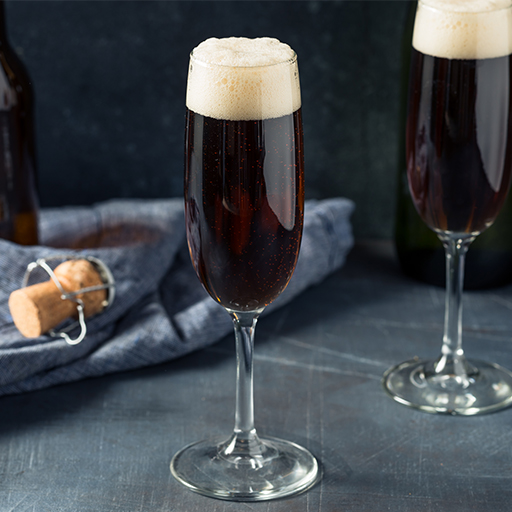
GUINNESS BEER: ALWAYS SERVE IT COLD AND CREAMY
Baltimore Guinness Ambassador Ryan Wagner shares how he keeps the beer's heritage alive by serving, storing, and drinking Guinness.
Estimated Reading Time: 5 minutes
As a National Ambassador for Guinness Open Gate Brewery in Baltimore, Maryland, Ryan Wagner’s job is to bring the spirit and heritage of Guinness to life every day. Read on as Ryan discusses how he works to keep stories alive through the ways Guinness is served, stored and drunk.
'FOR ARTHUR': THE BEGINNINGS OF THE GUINNESS WORLD RECORD

'FOR ARTHUR': THE BEGINNINGS OF THE GUINNESS WORLD RECORD
Guinness has been around for a long time: it turned 262 on January 31, 2021. This is the date Arthur Guinness signed the most iconic lease in real estate history.
On that date in 1759, Arthur agreed to lease a brewery in Dublin's St. James's Gate district for 9,000 years, the brewery that remains the home of Guinness to this day.
It was within the walls of St. James's Gate that Arthur and his colleagues began to build the brand that has become one of the most iconic and beloved in the world. And it is on the shoulders of those giants that the brand is built, always with a focus on the pillars of: integrity, passion, and quality.
All three pillars work hand in hand, but quality may be what sets Guinness apart in the beer world. Even in the first Guinness advertisement published in a national newspaper back in 1929, quality was a major theme.
The Guinness family has always known the most important truth about beer: the measure of a brewer is not just his ability to make a great beer, but his ability to make it again and again. Consistency and quality go hand in hand.
That dedication extends not just to the brewery walls, but also to the more than 150 countries where our beer is served. Guinness may travel thousands of miles to reach its destination in some cases, but the most important part of the journey may be in the last few meters from keg to glass – the final link in the quality chain.
GUINNESS IS A DISH BEST SERVED COLD: USE OF THE COLD ROOM

GUINNESS IS A DISH BEST SERVED COLD: USE OF THE COLD ROOM
Beer quality is a complex and ever-evolving craft, but gaining a basic understanding of the most common issues that can occur helps solve the vast majority of challenges faced within a bar or pub. Here are some basics, starting with the draft system elements in the cold box or walk-in cooler to help achieve consistent freshness.
TEMPERATURE
Despite the many rumors circulating, Guinness beer should always be served cold. Beer is a food product and should be treated as such. The longer and more consistently you keep your beer at the proper cold temperatures, the slower the aging process. Additionally, correct temperatures are required to keep the gas within the beer in its proper balance.
Beer that is too warm will foam up due to the agitated CO2. Beer that is too cold will not allow for ideal foam formation and retention. Fortunately, we know the perfect temperature for preserving beer: 38 degrees Fahrenheit or 3 degrees Celsius.
Set up your cold storage and rest easy knowing your beer is in its happy place! Also, a quick reminder: kegs take a full 24 hours to acclimate to cold room temperature. If your kegs arrive at room temperature, it will take them a full day to reach the proper temperature. Get them into the cold storage ASAP!
PRESSURE
A draft system is only effective if it is in balance. That balance is based on pressure. The regulators that control the pressure and maintain the balance within the keg must be set to specific settings to pour the perfect beer.
In the case of Guinness Draught Stout, that setting is between 30 and 38 PSI. Other beers require their own unique adjustments. Too low or too high and the pour will suffer causing issues with flavor and carbonation. Your distributor or local quality team will be able to adjust this for you if needed.
CLEANING
A draft system has many components (couplers, FOBs, beer pumps, lines, taps) and any of them can disrupt the pour if not kept clean and in proper working order. The frequency and methods by which the system should be cleaned are very specific.
In most cases, that process should be performed by trained professionals, but understanding those processes can help you ensure that the work is done as frequently and with the quality required.
In the US, lines should be cleaned every two weeks with a caustic solution. Taps should be disassembled and detailed in the same cycle. Couplers and FOBs should be taken apart and cleaned as part of a quarterly deep clean when an acidic solution is used to give the beer lines a more thorough clean. In Ireland and the UK, quality equipment will do this for you, and other countries also have their systems to keep their equipment running as it should, but it's always good to know what each component does!
In short, treat your cold storage and draft system components as if they were part of your food program – in many ways, they are.
QUALITY CREATION: TIPS TO MAINTAIN THE CONSISTENCY OF YOUR POUR
The cold room isn’t the only place where the quality chain can be broken. Behind the bar is another, where glassware and pouring techniques can also play an important role. Essential bar skills will help you pour a beautiful pint at every service.
GLASSWARE
This is perhaps the most consistent issue when it comes to draft beer challenges in retail settings. Believe it or not, clean glassware is essential to the appearance, aroma, and flavor of a beer. Here are some best practices:
Keep your dishes, coffee cups, milk jugs, etc., and beer glasses in separate washers, to prevent food or dairy residue from getting into the glasses.
Allow glassware to air dry by placing it on shelves that allow air to circulate inside.
If you use a disinfectant, allow the disinfectant to dry completely before pouring it in.
Never chill or freeze your glassware: Ice crystals that form on the inside of the glass create nucleation points that cause the beer to foam. Frozen glasses almost always lead to wasted beer!
HOW TO SERVE THE PERFECT PINT OF GUINNESS

HOW TO SERVE THE PERFECT PINT OF GUINNESS
One of the main questions brewers ask themselves is how to pour the perfect pint. Here is a guide to pouring a Guinness Draught Stout using the 'Six Steps to Perfection':
Select a clean, fresh Gravity Glass.
Holding the glass at a 45-degree angle to the faucet, turn it on fully by pulling the handle toward you.
As the beer fills, adjust the glass upright, turning off the tap when the beer reaches the top of the golden harp at the front of the glass.
Allow the beer to settle completely, until the entire pint is a uniform color. This should take about 90 seconds.
Fill the beer by pushing the tap handle away from you, until the beer is just over the edge of the glass. The total height of the head should be between one-half and three-quarters of an inch, or 12-18 mm.
Serve the glass with the Guinness logo facing the guest.
PUT YOUR PERSONALITY IN YOUR PINT: SERVE WITH PASSION
Despite all of the above, something else that impacts the quality of the beer is the passion and stories provided by a bartender that can impact the experience of drinking a beer. The quality of the beer is vitally important but equally important is that the bartender brings his authentic self to the process. When those two elements are in balance, the pints will be perfect.
FIVE KEY TAKEAWAYS
Temperature is vitally important, both for the quality of the pour and for the quality of the beer itself. And no, Guinness should not be served at room temperature!
Having a balanced draft system with the correct pressures at all times is a fundamental part of the quality chain that is often overlooked. Small mistakes can cause big problems.
The importance of regular and proper cleaning and maintenance of your draft system cannot be overstated. Learn the basics so you can get that process under control.
Simple pouring techniques and clean glassware make a big difference. These are quick and easy adjustments that will save you a lot of beer over time.
Don’t forget the role YOU play in this process! The best beer in the world served through the best keg system will still fail if the experiential elements created by the bar staff are not in place.
Sign up for free and become a member of Diageo Bar Academy today to unlock the latest industry news, trends, and tips to keep your bar knowledge up to speed!
Check out some recipes
Related Content

An Expert Guide to Pouring the Perfect Guinness
National Ambassador for the Guinness Open Gate Brewery, Ryan Wagner, shares his expertise on how Guinness is best stored, poured and served.
Brilliant Beer Cocktails
Padraig Fox, Guinness Global Brand Ambassador, shares a few ways to shake up your menu, and add a little fizz to your cocktails.
An Expert Guide To Beer Flavors & Styles
Learn about the different types of beer and the flavors they best pair best with in this webinar, presented by expert sommeliers Padraig Fox and Ian Colgan.
How to Pour the Perfect Pint of Guinness: Troubleshooting Quiz
How good are you at pouring Guinness? Find out how to consistently pour a beautiful pint of Guinness with this troubleshooting quiz.


